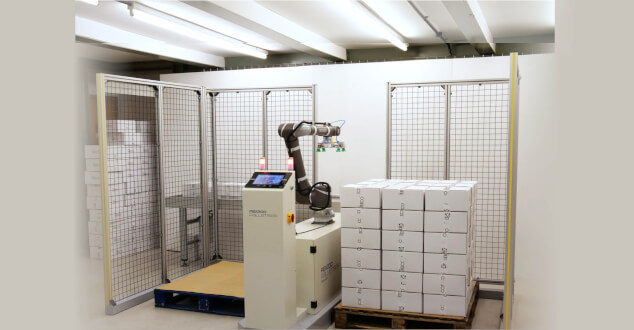Green packaging industry: How to achieve sustainable manufacturing
Julkaistu 09. helmikuuta 2022: Sustainable Manufacturing
Green packaging industry: How to achieve sustainable manufacturing
Sustainability in the packaging industry is one of the key aspects in fighting the plastic waste issue and ultimately climate change. The challenges that this presents, require flexible and powerful automation technology.
Five pillars of sustainable packaging
Key points to consider for a more sustainable packaging: First thing to address is, reducing packaging material – not only in terms of virgin plastics content in primary packaging, but also in the amount of protective secondary and final packaging. Another point to work on, is to eliminate the need for single-use packaging. Some strategies to tackle this issue start with increasing the use and scaling of reusable and refillable systems, redesigning the package with alternative packaging materials that facilitate recycling, are biodegradable, compostable or have lower impact in the environment if they end up in the landfill. Packaging made from monomaterials is another strategy attracting increasing interest in the packaging industry. They have better recyclability but migrating to them could be a challenging process that requires strict process control as many times, packaging equipment need to be adapted or customized to achieve an advanced form, fill and seal process that ensures the same package quality and performance.New requirements for production facilities
Looking at one of the strategies for more sustainability in the packaging industry is reducing the amount of plastic, specially if its virgin. A key tactic to do it is shifting from rigid to flexible packaging. Thinner walls, smaller sizes, narrower seams, and lighter weights are a good way to reduce the amount of virgin plastic used in the primary container. Added to this are the use of monomaterials already mentioned, paper-based and biopolymers, as well as an increase in the proportion of recycled material in main packaging, protective and transport packaging (primary, secondary and final packaging). This has implications for processes and technologies on the factory floor that need to be revisited: for example, companies need to check the compatibility of their equipment and adjust settings if necessary. Lines need to be flexible to change over to new materials. Linking and managing new machine-to-machine information is required. It is also necessary to control the performance of the machines under the new conditions and to avoid waste as much as possible.Switch to new materials, ensure quality and safety
If more sustainable materials are used in packaging, it is still of the highest importance to ensure the quality of the end product. At the manufacturing line changing to more sustainable materials means avoiding typical problems in the primary package like material jams or tears, poor quality seal, or incorrect labeling.1. Challenge film jamming
Thinner, recycled films are more sustainable, but can also tangle more quickly. Even slight changes in film thickness lead to uneven winding and unwinding and increase the tension on the film. Uneven tension, in turn, causes defects during pouch forming or sealing, such as curling, ripping, folding, or a sideways shifting or misalignment. Correct handling with maximum throughput and minimum film consumption is key to overall OEE (Original Equipment Effectiveness). Therefore, if creases are forming in the seal, operators should check for machine errors that are contributing to the film not being fed correctly. Examples include misaligned rollers, different feeding devices, or stuck rollers that do not rotate freely. OMRON‘s Film Tension Control System provides synchronised control of tension, feed, and cut. This is complemented by (colour) mark detection for film compensation through motion control to ensure optimal unwinding of the roll. The OMROM Packaging Library offers a wide range of function blocks for film processing in VFFS machines.2. Challenge film sealing
Thinner film materials offer lower costs and improved aesthetics. However, these materials are more sensitive to heat and susceptible to burn through when using traditional adhesives and sealing technologies. The actual sealing temperature must therefore be constantly and precisely controlled and automatically adjusted to avoid losing productivity or sealing defects that will generate rejects and waste. OMRON addresses this challenge with an AI-based temperature control algorithm synchronised with machine movement and sensor technology that can be placed closer to the sealing bar. Noise is compensated for by an automatic filter adjustment function.3. Challenge quality control of packaging and label
Reclosable packaging or pouches with nozzles are increasingly replacing rigid plastic containers. Flexible packaging with new elements such as resealable closures place different demands on packaging integrity and quality testing. Thinner films, bio-based materials, or those with a higher recycled content have a different thermal, elongation, and puncture resistance profile. These differences can lead to irregularities in the shape and edges during forming and cutting. More sustainable materials such as non-laminated or monomaterials also change shape and can reduce the fidelity or performance of label printing. Reading, checking, or verifying label information on packaging is difficult when the shape is inconsistent or the print quality changes. OMRON addresses this with its High-Speed Inspection System: this simple and scalable system is suitable for multiple lines and transparent integration with robotic systems. It offers a multi-camera platform with a single controller for multiple-image capture at high speed to reliably detect potential defects. Advanced algorithms help to detect difficult-to-read characters, in variable light conditions and high speeds.
4. Challenge of new adhesives and gluing techniques
Eliminating tapes and minimizing adhesives increases the recyclability of cartons. Removing the need for a silicone strip makes it 100% recyclable and biodegradable. To produce and seal cartons, companies are increasingly relying on a strategic and reduced application of adhesives. This requires a high level of precision and continuous quality control. With its automated visual inspection system, OMRON supports accurate detection of glue patterns. The high resolution and brightness settings allow low-contrast defects to be detected, even in the toughest light conditions or with difficult to detect materials.5. Challenge of multi-material handling
Cardboard boxes made of recycled fibers have higher porosity and are more flexible. Using traditional machines or unpacking and repacking manually, the handling of boxes made of recycled cardboard without damaging them can be tricky. Traditional palletizing solutions are complicated to adapt and program, they take up a lot of space, and cannot be relocated to other parts of the plant when needed. It is therefore advisable to have an integrated collaborative robot (cobot) solution with dedicated grippers to safely handle a wide range of irregular shapes, porosity levels, and delicate objects.
